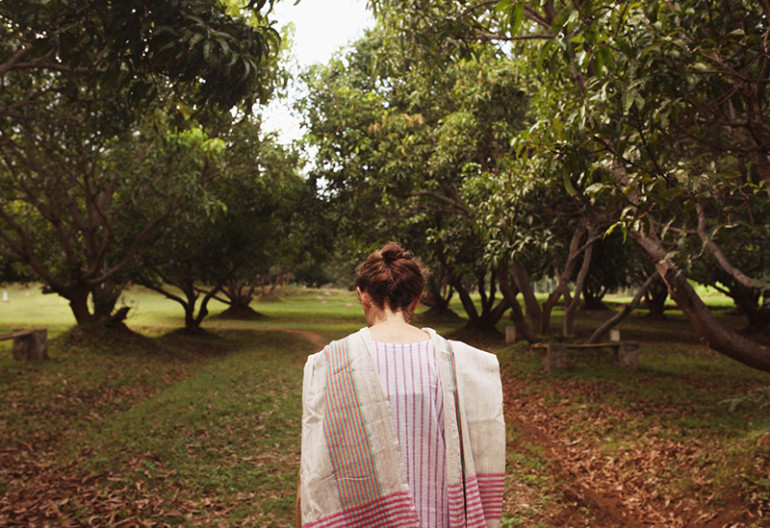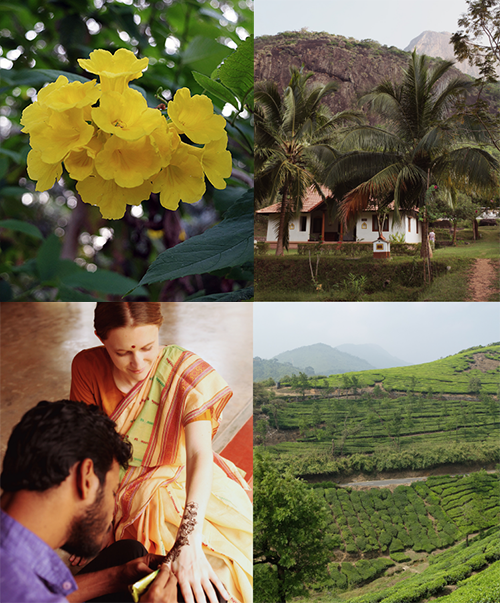 PHOTOGRAPHS BY ZAHID SARDAR AND COURTESY OF MAITREYI—THE VEDIC VILLAGE
PHOTOGRAPHS BY ZAHID SARDAR AND COURTESY OF MAITREYI—THE VEDIC VILLAGE
IN THE SHADOW of India’s Anaimalai Mountains that form the southern end of the Western Ghats range in Tamil Nadu, I arrived at Maitreyi, a secluded enclave named after a female sage, where I was instantly catapulted into a wonderland of ancient Indian life.
Despite the occasional cry of peacocks or two resident Brahmin priests’ sonorous ringing of temple bells, this green and orderly paradise invites meditation and introspection — whitewashed brick-and-wood buildings with broad verandas and red tile roofs sit amid stately coconut palms and flowering trees.
Maitreyi appears as if it has always been there. But it was only about eight years ago when co-founder Markus Dietl, now 63, launched the retreat on undeveloped acreage sandwiched between the forested ghats and the Aliyar River.
“It was ideal for the Vedic village we envisioned,” Dietl says.
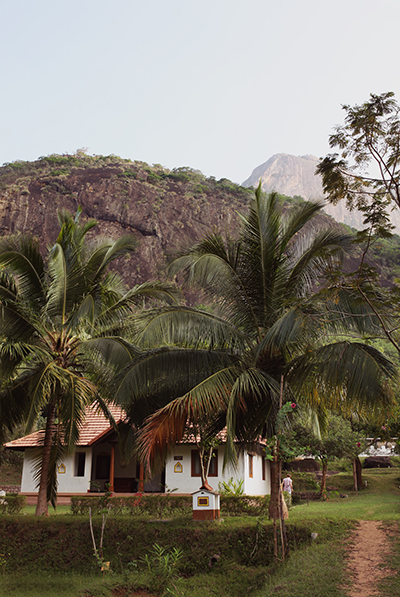
Dietl is a disciple of the late Maharishi Mahesh Yogi, the globe-trotting guru who more than 50 years ago revived ideas from the Vedas, the oldest Hindu sacred texts, for living a deeper spiritual life, introducing transcendental meditation (TM) to the West and influencing the likes of the Beatles, Buckminster Fuller and Deepak Chopra. The Maharishi died in 2008 in Vlodrop, the Netherlands, where, oddly, he last lived on the forested grounds of a former Franciscan monastery.
That’s when Dietl — who first encountered the worldwide TM movement during the 1970s in Munich, Germany, where he was a university student — fully realized the notion of a Vedic retreat in the heart of India, “in harmony with the forgotten laws of nature,” he says.
“I was teaching TM all over India for a long time and thought that a fixed place to manifest the principles we taught was a good idea,” Dietl recalls. The plan grew to include a meditation and yoga center and buildings for the practice of Vedic Ayurveda, aka the healing science of life.
With eight collaborators, three of them now also Maitreyi directors, Dietl, who grew up in the Italian Alps, considered several northern options, including a village outside Kolkata, before they found their dream spot near the Aliyar dam and the border of Kerala.
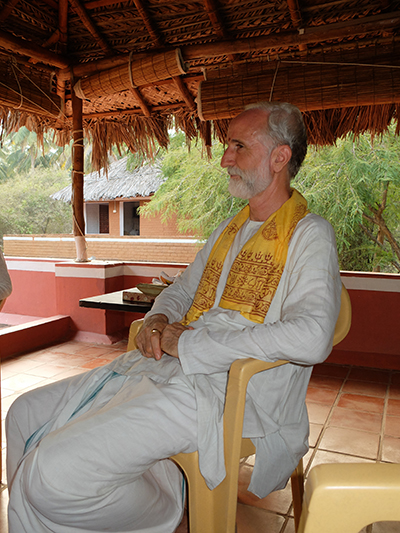
They gradually developed it with the help of architect Prabhat Poddar of the Sri Aurobindo ashram in Pondicherry, just south of Chennai, where Vedic building forms abound, but few in such organized profusion as at Maitreyi.
According to Vedic tenets that include Vastu principles (a kind of Indian feng shui), Poddar drew a surface grid that charts underground negative and positive electromagnetic forces; permanent brick or stone columns demarcate the intersections of this invisible energy grid LANDING that are thought to be ill suited to the presence of buildings and people.
According to Dietl, Vastu ideas were mostly lost in India until their recent revival, thanks to advocates like Poddar.
“We need to live again in accordance with nature. When that knowledge is lost, there is a danger,” Dietl says. “The pillars we erected at the grid crossings are to remind us not to ever sit or sleep there.”
On five acres with the best views of the mountains, Poddar laid out his square mandala-shaped plan for up to 25 roughly 500-square-foot freestanding brick, stone, wood and plaster cottages for guests and caretakers, a 3,500-square-foot meditation center, massage rooms, a combined office and store, and a second- floor cafe above a utility shed. On the rest of Maitreyi’s 20 acres abutting this assemblage are an organic potager garden, coconut palm and fruit orchards, and a teak grove interspersed with a few sandalwood trees, all fertilized with manure from the goshala (cowshed/dairy) built close to a banana plantation.
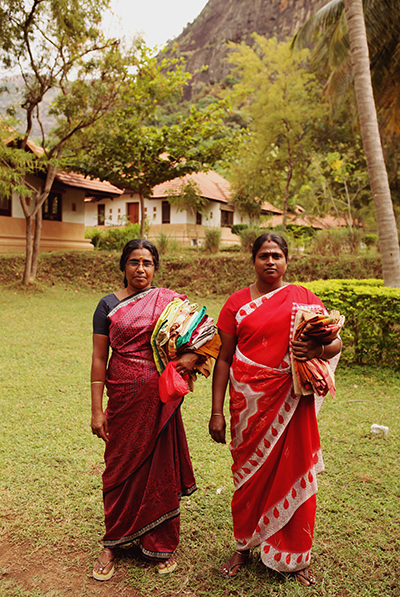
“The purpose of setting up a permaculture environment like this is to help others to also understand and implant it in their lives,” Dietl says.
Once a week, guests, many from Europe and the United States, stay for at least a month and are treated to an informal lecture on the practicality of Vastu principles. A walk around the estate brings to life the assets of its fields and its mandala plan, and the natural logic of its structures designed by Kollam-based architect Niranjan Das Sharma.
For example, “because door openings are like funnels, they are centered on the building facade and have double doors that open inside to allow energy to flow in evenly,” Dietl says. Cross-ventilation is a given, thanks to window placements.
Despite the impressive scale of Maitreyi’s largest so-called “earth-energy” buildings, which deliberately have no air-conditioning, Dietl says they are economical; their showy carved Rajasthan sandstone columns seem lavish but actually cost a lot less than the expensive hardwood used in some areas to weather a South Indian monsoon. The functional, comfortable interiors are decorated with elegant locally handmade furnishings. Currently, Dietl, inspired by Poddar, is also experimenting with low-cost geodesic-style domes composed of ultra-thin shells of brick that will someday serve as additional Ayurveda treatment rooms.
Speaking of Ayurveda, it “was forgotten even in South India before Maharishi popularized it in the 1980s,” Dietl says. “He was interested in bringing ancient ways back and in creating a scientific platform.”
Nowadays, most spa-goers around the globe know about Ayurveda, even though traditionally it was more than a spa treatment. “Shirodhara (dripping oils or milk onto the forehead) is powerful and it can do harm if wrongly administered,” Dietl cautions.
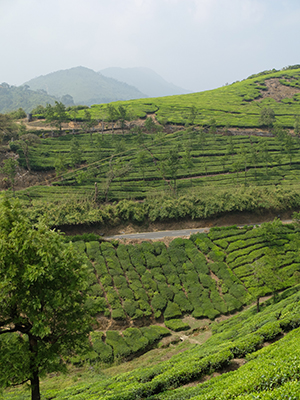
Accordingly, Maitreyi also has a resident Ayurveda expert, the young Dr. Abilash Anand, who is in his early 30s. He was guided by one of the Ashta Vaidya families of Trichur, Kerala, who are among the last hereditary South Indian vaidyas or doctors and custodians of ancient herbal secrets. He and his wife, Dhanusree, who is also a vaidya, greet guests at the Maitreyi clinic building and discuss a person’s health in detail before prescribing treatments, which can include detoxifying panchkarma therapies. “We only do traditional abhyanga (oil baths) and it is not a universal wellness treatment,” Anand warns. “If you have a flu or fever, and if something is amiss in the body, it won’t readily absorb the oil.”
Indeed, Maitreyi’s every aspect is carefully prescribed, including the mildly spiced garden-fresh food, which is strictly vegetarian, devoid of garlic and onions, and served in traditional-style metal dishes (albeit shiny stainless steel) in the large dining hall at fixed mealtimes only. A plant program further educates guests and patients on how to identify, grow and use herbs and plants for aromatherapy.
During the day, after yoga salutations to the rising sun or a session of TM on the center’s veranda, or in between Ayurveda treatments, volunteering in the organic gardens, or sipping coconut water at the cafe, guests can go to nearby Pollachi to visit the 11th-century Samathur Shiva temple or see the weaving of textiles at organic Appachi Eco-Logic Cotton mills; watch a sari-wearing demonstration or a folk dance before a puja ritual; or drive up into the ghats to visit breathtaking tea estates around Valparai. On the latter excursion one afternoon, the rare Nilgiri tahr, a horned goat antelope, appeared along a vertiginous roadway to the top — an experience that’s definitely transcendent, in broad daylight, with one’s eyes wide open.
By contrast, isn’t transcendental meditation more like a deep sleep?
“No, meditation is the opposite of sleep,” Dietl says, with unusual emphasis and perhaps a little irony. “Meditation is a deeper rest but you are fully alert. It is an awakening. You find your way there with your eyes closed and by concentrating on an inner sound.”
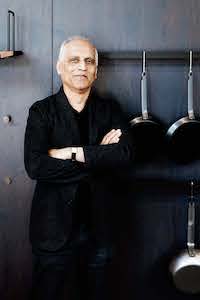
Zahid Sardar brings an extensive range of design interests and keen knowledge of Bay Area design culture to SPACES magazine. He is a San Francisco editor, curator and author specializing in global architecture, interiors, landscape and industrial design. His work has appeared in numerous design publications as well as the San Francisco Chronicle for which he served as an influential design editor for 22 years. Sardar serves on the San Francisco Decorator Showcase design advisory board.

